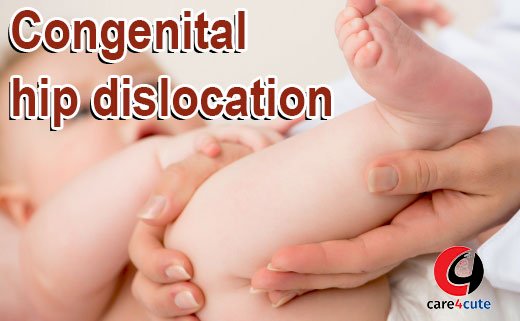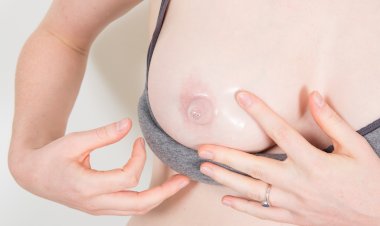Congenital Hip Dislocation in Newborn

Congenital Hip Dislocation
Congenital hip dislocation occurs when a child is born with an unbalanced hip. It’s caused by abnormal development of the hip joint during intrauterine life. It is also called as “developmental dysplasia of the hip.” This condition worsens as child grows.
The hip joint attaches the thigh bone (femur) to the pelvis. The top of the femur (femoral head) is rounded, like a ball and sits inside the cup shaped hip socket. In this way, hip joint is a ball and socket type of joint that is held in place by ligaments. The ball-and-socket joint in the child’s hip may sometimes displace. This means that the ball will slip out of the socket by movement. The joint may sometimes completely displace. According to sources in India, the incidence has been reported to be 1.0–2.0 per 1000 in different studies with the incidence being more in north India.
Without treatment DDH can cause problem later in life like developing a limp, or painful and stiff joint. With early diagnosis and proper treatment, most of the cases can be corrected and a full range of movement in their hips can be ensured.
95–98% of hip dislocation cases are possibly reversible.
Cause and Risk factors
The cause is unknown in many cases. Risk factors factors include low levels of amniotic fluid in the womb, breech presentation, and a family history of the same condition. Hip Dysplasia is 12 times more when there is a family history of same illness in previous siblings. Babies in the breech position inside uterus are more chances to develop hip instability than babies in a normal uterine position.
Primi gravida mother has more chances to have a baby with this condition because uterus hasn’t been previously stretched.
DDH may affect 1 or both hips, but it's more common in the left hip. It's also more common in girls.
Infant positioning during the first year of life in various cultures have also some role in development of this condition. In cultures where infants are kept straight ( swaddled) have high chances of hip dysplasia in their babies, while in cultures where infants are hold with their legs apart have very less chances of this condition.
Symptoms:
Congenital dislocation of hip is usually diagnosed at the time of newborn examination by your child specialist but hip dysplasia can develop after some time in few children. That's why this condition is called developmental dysplasia. It is a silent condition as it doesn't cause any pain or deformity during initial few years.
Here are few signs that parents can notice in their babies which can point toward this condition.
1. Asymmetrical buttock creases
2. Hip clicks and pops
3. Difficulty in wearing diaper
4. Painless limp or discrepancy in leg length in older child
5. Delayed gross motor development, which affects child sitting, crawling, standing and walking.
Diagnosis:-
Screening for hip dislocation is done either at birth or during the first year of life. The most common method is a physical examination. Doctor will gently move child’s hip and legs while listening for clicking or clunking sounds that may indicate a dislocation. There are two types of test:
- Ortolani test: Doctor will apply upward force while they move child’s hip away from the body. Movement away from the body is called abduction.
- Barlow test: Doctor will apply downward force while they move child’s hip closed to the body. Movement towards the body is called adduction.
These tests are accurate in first 3 months of life. In older babies and children, findings that indicate hip dislocation include limping, limited abduction, and a difference in leg lengths if child have one side of hip dislocation.
Imaging tests can confirm a hip dislocation diagnosis. Doctors will do ultrasound examination for younger babies and use X-rays to examine older babies.
Treatment:-
If child is younger than 6 months of age and diagnosed with this condition, it’s likely they’ll be best for a Pavlik harness. This harness will help their hip joints into the sockets with pressure. The harness abducts the hip by securing their legs in a froglike position. Child may wear the harness for 6 to 12 weeks, depending on their age and the severity of the disease. Child may need to wear the harness full time or part time.
Child may need surgery if treatment with a Pavlik harness is not successful, or child is too old for the harness. Surgery will be under the general anesthesia and may include maneuvering their hip into the socket; this process is called a closed reduction. In some cases Surgeon will lengthen child’s tendons and remove other obstacles before positioning the hip. This is called an open reduction. After child’s hip is placed into position, their hips and legs will be in casts for at least 3 months.
If child is 18 months or older or hasn’t responded well to treatment, they may need femoral or pelvic osteotomies to reconstruct their hip. This means a surgeon will divide or reshape the head of their femur (the ball of the hip joint), or the acetabulum of their pelvis (the hip socket).
Prevention:-
You can’t prevent hip dislocation but it’s important to bring your child to regular checkups so doctor can identify and treat the condition as soon as possible. You should verify that your doctor have examined your newborn for signs of hip dislocation before you leave the hospital after delivery.
Outcome:-
Complication and invasive treatment is less likely to happen if doctor identifies disease early and child received treatment with a Pavlik harness. It’s estimated that between 80 and 95 percent of cases identified early receive successful treatment, depending on the severity of the condition.
Surgical treatments differ in their success rates. Many cases only need one procedure, and others require many surgeries and years of monitoring. Hip dislocation that’s not successfully treated in early age can result in early arthritis and severe pain later in life that might require total hip replacement surgery.
If child’s is successfully treated, they’ll more likely continue to regularly visit an orthopedic specialist to make sure the condition doesn’t relapse and that their hip is developing normally.







































Comments (0)